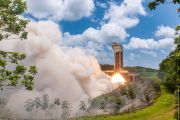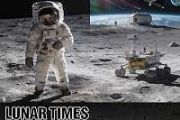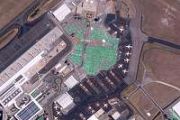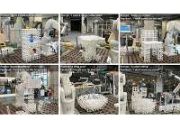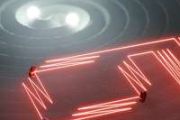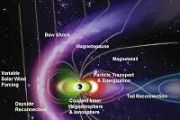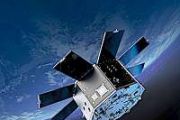
Copernical Team
Intercontinental team to grow protein crystals in space
 An interdisciplinary team including Alexandra Ros, professor in Arizona State University's School of Molecular Sciences and faculty member in the Biodesign Institute's Center for Applied Structural Discovery, is taking one giant leap into a new sector of the global aerospace industry.
The team has received $9.87 million from the Ministry of Business, Innovation and Employment Endeavour Fun
An interdisciplinary team including Alexandra Ros, professor in Arizona State University's School of Molecular Sciences and faculty member in the Biodesign Institute's Center for Applied Structural Discovery, is taking one giant leap into a new sector of the global aerospace industry.
The team has received $9.87 million from the Ministry of Business, Innovation and Employment Endeavour Fun ESA advances satellite testing capabilities at Europe's largest thermal vacuum facility
 In the realm of space exploration, testing equipment under conditions that mimic the unforgiving environment of space is critical. At the forefront of this endeavor is the European Space Agency's (ESA) Large Space Simulator (LSS), located at the ESTEC Test Centre in Noordwijk, the Netherlands. This mammoth facility, known for its capability to simulate the vacuum, temperature, and solar radiatio
In the realm of space exploration, testing equipment under conditions that mimic the unforgiving environment of space is critical. At the forefront of this endeavor is the European Space Agency's (ESA) Large Space Simulator (LSS), located at the ESTEC Test Centre in Noordwijk, the Netherlands. This mammoth facility, known for its capability to simulate the vacuum, temperature, and solar radiatio A Fractured Filled Plan: Sols 4073-4075
 Earth planning date: Friday, January 19, 2024: This 3 sol weekend plan, like many of our recent plans (for example: here and here), focuses heavily on the fractures and cracks in this area. We are interested in cracks and fractures and the fracture fill (the material between cracks) as the chemistry and the physical features can tell us lots about conditions at the time of their formation, inclu
Earth planning date: Friday, January 19, 2024: This 3 sol weekend plan, like many of our recent plans (for example: here and here), focuses heavily on the fractures and cracks in this area. We are interested in cracks and fractures and the fracture fill (the material between cracks) as the chemistry and the physical features can tell us lots about conditions at the time of their formation, inclu Japan says 'possibility' Moon lander power can be restored
 Japan switched off its Moon lander almost three hours after a historic touchdown to allow for a possible recovery of the craft when the sun hits its solar panels, the space agency said Monday.
With its unmanned Smart Lander for Investigating Moon (SLIM) mission - dubbed "Moon Sniper" for the craft's precision landing capabilities - Japan became the fifth country to achieve a soft lunar lan
Japan switched off its Moon lander almost three hours after a historic touchdown to allow for a possible recovery of the craft when the sun hits its solar panels, the space agency said Monday.
With its unmanned Smart Lander for Investigating Moon (SLIM) mission - dubbed "Moon Sniper" for the craft's precision landing capabilities - Japan became the fifth country to achieve a soft lunar lan China hopes Chang'e 6 can return samples from Lunar Far Side
 China is poised to take another significant step in lunar exploration with its upcoming Chang'e 6 mission, scheduled for later this year. This ambitious endeavor by the China National Space Administration (CNSA) aims to collect and return samples from the far side of the Moon, a feat not yet accomplished by any nation.
The Chang'e 6 spacecraft, a complex assembly comprising an orbiter, lan
China is poised to take another significant step in lunar exploration with its upcoming Chang'e 6 mission, scheduled for later this year. This ambitious endeavor by the China National Space Administration (CNSA) aims to collect and return samples from the far side of the Moon, a feat not yet accomplished by any nation.
The Chang'e 6 spacecraft, a complex assembly comprising an orbiter, lan Aqualunar Challenge Launches: UK-Canada Initiative for Lunar Water Purification
 The realm of space exploration is on the verge of a significant advancement with the introduction of the Aqualunar Challenge, a collaborative GBP1.2 million initiative between the UK and Canada, aimed at fostering the development of technologies for purifying water on the Moon. This challenge is a testament to the growing focus on making human habitation on the lunar surface a viable reality.
The realm of space exploration is on the verge of a significant advancement with the introduction of the Aqualunar Challenge, a collaborative GBP1.2 million initiative between the UK and Canada, aimed at fostering the development of technologies for purifying water on the Moon. This challenge is a testament to the growing focus on making human habitation on the lunar surface a viable reality. Small solar sails could be the next 'giant leap' for interplanetary space exploration
 Nearly 70 years after the launch of the first satellite, we still have more questions than answers about space. But a team of Berkeley researchers is on a mission to change this with a proposal to build a fleet of low-cost, autonomous spacecraft, each weighing only 10 grams and propelled by nothing more than the pressure of solar radiation. These miniaturized solar sails could potentially visit
Nearly 70 years after the launch of the first satellite, we still have more questions than answers about space. But a team of Berkeley researchers is on a mission to change this with a proposal to build a fleet of low-cost, autonomous spacecraft, each weighing only 10 grams and propelled by nothing more than the pressure of solar radiation. These miniaturized solar sails could potentially visit Salad in space? New study says it's not a healthy choice
 Lettuce and other leafy green vegetables are part of a healthy, balanced diet - even for astronauts on a mission. It's been more than three years since the National Aeronautics and Space Administration made space-grown lettuce an item on the menu for astronauts aboard the International Space Station. Alongside their space diet staples of flour tortillas and powdered coffee, astronauts can munch
Lettuce and other leafy green vegetables are part of a healthy, balanced diet - even for astronauts on a mission. It's been more than three years since the National Aeronautics and Space Administration made space-grown lettuce an item on the menu for astronauts aboard the International Space Station. Alongside their space diet staples of flour tortillas and powdered coffee, astronauts can munch A massive cluster is born
 Image:
Image:
This image from the NASA/ESA/CSA James Webb Space Telescope features an H II region in the Large Magellanic Cloud (LMC), a satellite galaxy of our Milky Way. This nebula, known as N79, is a region of interstellar atomic hydrogen that is ionised, captured here by Webb’s Mid-InfraRed Instrument (MIRI).
N79 is a massive star-forming complex spanning roughly 1630 light-years in the generally unexplored southwest region of the LMC. N79 is typically regarded as a younger version of 30 Doradus (also known as the Tarantula Nebula), another of Webb’s recent targets. Research suggests that N79 has a star formation efficiency
NASA's Roman to Search for Signs of Dark Matter Clumps
 Some of the finest, smallest details in the universe - the gaps between elongated groups of stars - may soon help astronomers reveal dark matter in greater detail than ever before. After NASA's Nancy Grace Roman Space Telescope launches, by May 2027, researchers will use its images to explore what exists between looping tendrils of stars that are pulled from globular clusters. Specifically, they
Some of the finest, smallest details in the universe - the gaps between elongated groups of stars - may soon help astronomers reveal dark matter in greater detail than ever before. After NASA's Nancy Grace Roman Space Telescope launches, by May 2027, researchers will use its images to explore what exists between looping tendrils of stars that are pulled from globular clusters. Specifically, they 











